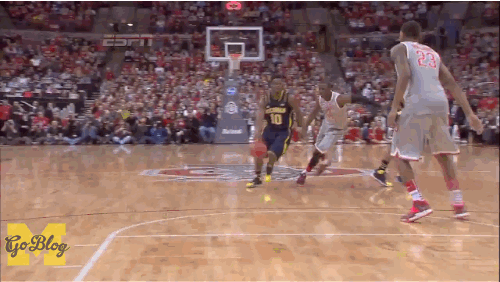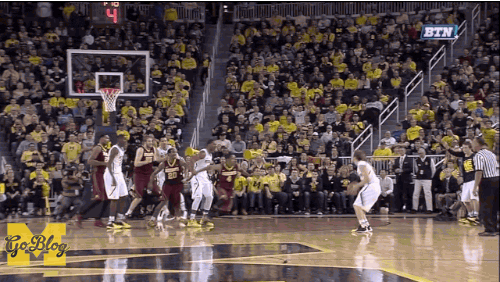Previously:Gardening Lessons
Image may be NSFW.
Clik here to view.
[Bryan Fuller/MGoBlog]
While the rest of the roster deals with a good amount of turnover, point guard is a comforting constant for Michigan this season thanks to the return of starter Derrick Walton and invaluable backup Spike Albrecht.
Although both point guards return, their roles—especially Walton's—should be quite different with the departure of Nik Stauskas, who ran the show on offense for much of 2013-14. Caris LeVert will continue to handle the ball quite a bit himself, but Walton will either be the second or third option when he's on the court, and with Stauskas gone Albrecht's shooting off the bench becomes more valuable, as well.
These two will also be asked to provide much of the leadership for this young squad. A true junior who recently turned all of 22 years old, Spike is the oldest player on this team—I KNOW, RIGHT?—and John Beilein has discussed his importance as a leader several times this offseason, including at today's Big Ten Media Day:
Q. I was wondering if you could talk about Spike and how you've seen him develop since he got on campus, particularly from last season to this season?
JOHN BEILEIN: It's amazing the confidence he has shown since the day he walked in the door. I mean, even when he came for his visit where he was what some people thought was an unlikely recruit, he was laughing about how unlikely people thought this was. And then every time he walks on the floor, he just -- he's got incredible confidence that "I can play at this level," and he's shown that so well. He's a pleasure to coach. He's become a really excellent team leader right now. I'm really leaning on him to be the pulse of the team.
Spike is the pulse, Walton the burgeoning floor general. Hit the jump for a deeper dive into what to expect from them this season.
[JUMP]
Derrick Walton
Image may be NSFW.
Clik here to view.
Year: Sophomore
Measurables: 6'0", 185
Base Stats: 26.7 MPG, 7.9 PPG, 45/41/79 2P/3P/FT%, 106 assists, 56 turnovers
Key Advanced Metrics: 18.2% usage, 112.2 ORating, 19.8 assist rate, 19.9 turnover rate
Walton came to Ann Arbor last year as a consensus top-50 recruit, and he displayed that level of potential while playing in a supporting role. He'll be asked to do a whole lot more this year, especially in the pick-and-roll game, and there were enough signs that he's destined for stardom last season that confidence is high in his ability to handle increased responsibility.
With Stauskas and LeVert handling much of the on-ball duties in 2013-14, freshman Walton spent much of time working as a spot-up shooter, and he was highly effective in this role, as Dylan's shot chart displays:
Image may be NSFW.
Clik here to view.
There'll be fewer spot-up opportunities this year, in all likelihood, but when he's able to work off the ball Walton remains a serious threat in this offense. He also showed major potential as a finisher; according to hoop-math, he hit 71% of his shots at the rim, and only 22% of those shots were assisted, figures that actually compared favorably to Stauskas (65%, 35%). Walton turned the clutch and-one into something of a signature last year, and he was able to create shots for himself both in transition and halfcourt sets; he'll be tasked with the latter a lot more this year, and the evidence suggests he'll be quite capable.
Walton will shoulder much more of the distribution load, and while his assist and turnover rates were nearly identical in his freshman year, those numbers tend to head in a very good direction for second-year point guards, especially those under John Beilein's and LaVall Jordan's tutelage. Walton and Zak Irvin both participated in the elite Adidas Nations camp during the offseason, and per College Basketball Talk, Walton's progress as a passer in the pick-and-roll directly benefited his college teammate:
On Friday Walton was very good with regards to distributing the basketball, making sound decisions in the pick-and-roll game and getting his teammates the ball where they were best positioned to enjoy success. One of the beneficiaries was teammate Zak Irvin, who knocked down multiple jump shots on the tail end of those Walton passes.
He'll also look to push the ball quite a bit after recording 35% of his assists in transition last season, the highest figure on the team. Walton is a good decision-maker on the fast break and he finishes well at the rim; he should only get better on that front as a sophomore.
On defense, Walton held his own for a freshman at a demanding position. Unlike his predecessor, he's got pretty ideal size to go along with plus athleticism, which helps make up for the fact that his steal rate was only half of what Trey Burke's was in his final season. Walton also chips in a good number of rebounds for a point; his 12.4% defensive rebound rate actually came in slightly ahead of Glenn Robinson III's figure last year. That's an underrated asset with Walton, as he's able to immediately turn those boards into fast break opportunities.
There are several spots one could point to heading into this season and say it's THE key for Michigan to continue their high level of success. Walton is one of them. If his three-point shooting can stay in the same range while he improves his on-ball efficiency, he should make a big push for all-conference honors, not to mention put the team in a position to win a whole lot of games.
Spike Albrecht
Image may be NSFW.
Clik here to view.
Year: Junior
Measurables: 5'11", 175
Base Stats: 14.7 MPG, 3.3 PPG, 44/39/78 2P/3P/FT%, 75 assists, 16 turnovers
Key Advanced Metrics: 13.8% usage, 126.1 ORating, 24.3 assist rate, 13.6 turnover rate
Spike may not become much more than what he was as a sophomore last year, but that's by no means a bad thing in this program. Even though his three-point percentage dropped from an anomalous 55% to a paltry-only-in-comparison 39%, his outside shooting off the bench remained a huge asset. While he'll never be a serious threat as a slasher, he also improved his arsenal inside the arc, becoming more reliable with his wonky-looking running scoop layup.
Meanwhile, Albrecht made massive strides as a distributor, raising his assist rate from 14.6% to 24.3% while slashing his turnover rate from 21.4% down to 13.6%; in Big Ten play, he dished out 35 assists against just five turnovers. It's tough to ask for much more out of a backup point guard—when Walton was ineffective, Beilein had the luxury of turning to Spike and knowing the offense would run smoothly, and Albrecht brought a confidence to the court that seemed to spread to his teammates.
While Spike's diminutive stature will always limit his defensive ability, especially against bigger and/or more athletic PGs, he had a knack for coming up with timely steals last season; his theft of a Roy Devyn Marble pass on a 2-on-1 break against Iowa, immediately leading to a fast-break score, comes to mind—that play essentially sealed M's victory over the Hawkeyes.
Even if Spike's game doesn't progress one iota—and under Beilein/Jordan, that's hard to imagine—he'll be one of the more valuable bench contributors in the conference in addition to being the vocal leader of this year's squad. He's liable to spark a huge run with his shooting—we all remember his title game performance, of course—and when he's quiet it's usually because his contributions aren't needed instead of any poor play on his part. (The exception to that comes when he struggles defensively; his minutes waned as M's competition stiffened late in the year, in large part because it didn't seem like a good idea to give him extensive time against, say, Kentucky.)
We should see around a 75/25 split in minutes between Walton and Albrecht. Beilein has the flexibility to play them both at the same time, as well; Spike's steadiness at the point allows for Walton to play off the ball and make use of his stellar spot-up shooting. There's little doubt about this: Michigan's point guard position is once again in good hands.